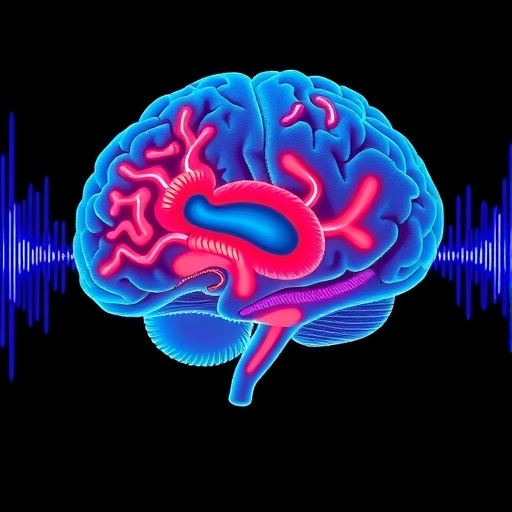Human brain’s extraordinary ability to learn and understand spoken language early in life is a hallmark of our species, yet this skill is distinctly shaped by exposure to specific languages. While we can often recognize familiar individual phonemes when hearing a foreign tongue, the ability to segment continuous speech into meaningful units such as words presents greater difficulty in unfamiliar languages. Until now, the neural mechanisms driving this disparity between native and foreign language perception have remained elusive.
In a groundbreaking study leveraging direct high-resolution electrophysiological recordings from the human brain, researchers have unveiled new insights into how experience with a native language shapes neural processing of speech. The temporal lobe, particularly the superior temporal gyrus (STG), is identified not only as a locus for fundamental acoustic-phonetic processing but also as a site where language experience distinctly tunes neural populations to native linguistic units. This challenges long-standing models that considered primary auditory regions as strictly language-agnostic processors of sound.
The study’s sophisticated neural recordings reveal that all human languages share a basic articulatory feature set encoded robustly by the auditory cortex. However, exposure starting before birth sculpts the brain to become highly sensitive to the precise phonetic inventory of the native language. This tuning facilitates the neural encoding of words and higher-order linguistic structures, processes substantially enhanced in the native language relative to foreign languages, highlighting a hierarchical neural coding scheme shaped by experience.
Contrary to traditional theoretical frameworks positing that the STG merely performs early spectrotemporal analysis before higher linguistic transformation occurs elsewhere, the findings show that acoustic, sublexical, and word-level features are processed concurrently within the STG. Intriguingly, distinct subpopulations of neurons within this region exhibit varying degrees of sensitivity to language familiarity, indicating that the STG serves as a critical nexus interfacing auditory perception with ingrained linguistic knowledge.
The researchers also document that language-specific neural activity is not confined to higher-level language areas but manifests in regions previously thought to encode mainly lower-level acoustic signals. The robust presence of native language word encoding in the STG suggests intrinsic plasticity and learning-dependent reconfiguration in these auditory cortical areas, reflecting complex neural dynamics underlying language comprehension.
While the study focused on lateral surface recordings of the temporal lobe, leaving out structures such as the primary auditory cortex on Heschl’s gyrus and subcortical auditory pathways, the data suggest these excluded regions might contribute differently to language processing. Prior research indicates that core auditory areas may demonstrate less sensitivity to phonological and lexical features, underscoring the specialized role of the lateral temporal cortex in integrating sound with linguistic knowledge.
The implications of these findings extend beyond basic neuroscience to developmental linguistics and second language acquisition. The difficulty adults face in achieving native-like proficiency after early critical periods may relate fundamentally to the challenge of parsing continuous speech into native-language-specific units. This study provides neural evidence that acquisition of word-level representations is a pivotal bottleneck in language learning later in life.
Moreover, bilingual individuals show overlapping neural substrates within the STG for processing their multiple languages, with some neural populations encoding information from both languages. This aligns with cognitive models proposing shared but flexible neural networks underlying multilingual speech perception. Notably, individual proficiency levels modulate the degree of language-specific neural encoding, highlighting plasticity contingent on linguistic experience and proficiency.
The study’s comprehensive approach emphasizes the importance of accounting for cultural and experiential diversity in language research, advocating for broadened linguistic sampling beyond traditionally studied languages. Such diversity is crucial for fully understanding universal and language-specific neural coding principles that govern human communication.
While the research opens new frontiers in decoding how experience shapes phonological processing at multiple levels in the brain, it also raises exciting questions about the extent of top-down modulation from other brain regions involved in language. Future work incorporating recordings from deeper temporal structures and subcortical auditory nuclei could elucidate additional layers of the language processing hierarchy.
Finally, this study has potential ramifications for educational and clinical practices. Understanding how native language experience molds neural circuits opens avenues for targeted language learning interventions and rehabilitation strategies for individuals with language-processing impairments. Tailored approaches could leverage the brain’s intrinsic plasticity to facilitate more efficient acquisition and recovery of language functions.
In sum, this research elucidates the remarkable dual nature of the human temporal lobe as both a shared processor of fundamental speech sound features and an experience-dependent hub for native language-specific representations. This nuanced understanding of the neural basis of language promises to reshape our grasp of communication, development, and the lifelong journey of language mastery.
Subject of Research: Neural mechanisms underlying shared and language-specific phonological processing in the human temporal lobe
Article Title: Shared and language-specific phonological processing in the human temporal lobe
Article References:
Bhaya-Grossman, I., Leonard, M.K., Zhang, Y. et al. Shared and language-specific phonological processing in the human temporal lobe. Nature (2025). https://doi.org/10.1038/s41586-025-09748-8
Image Credits: AI Generated




